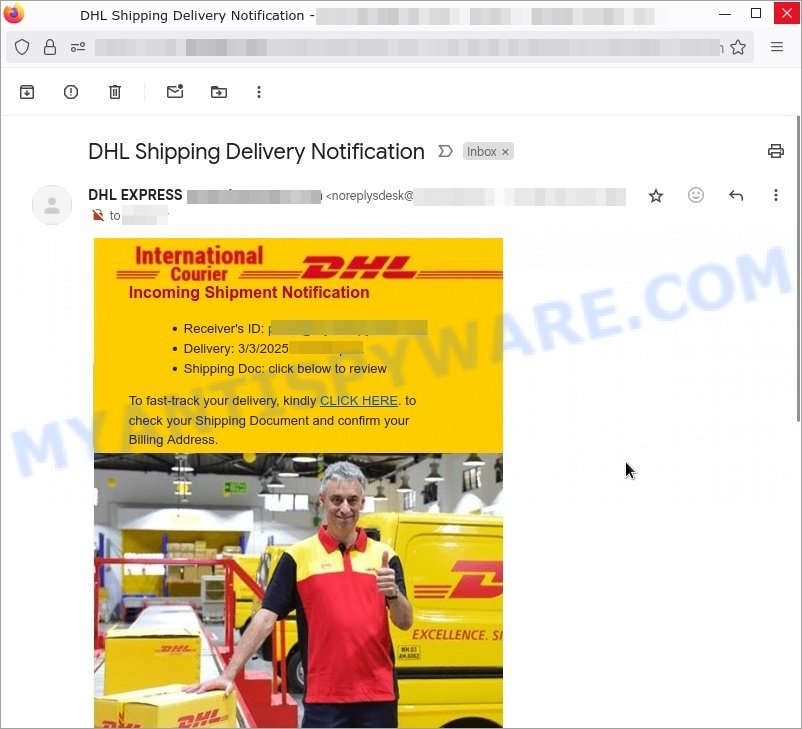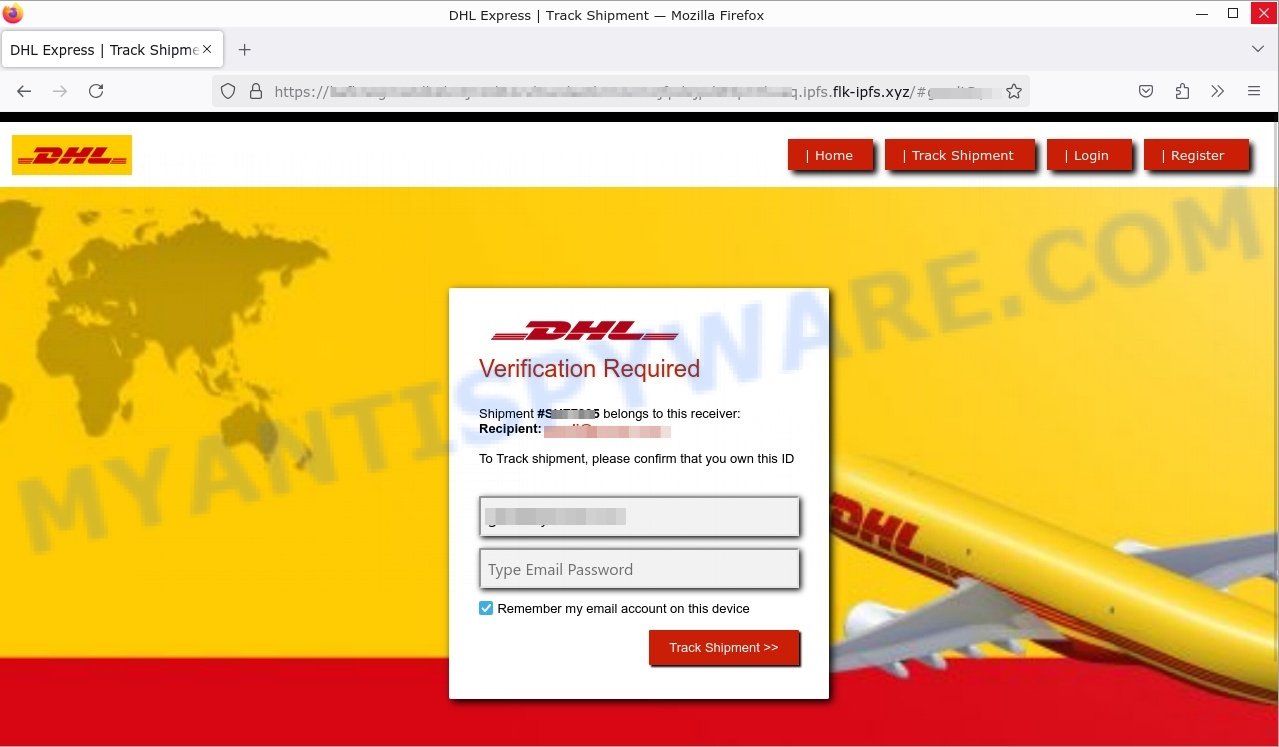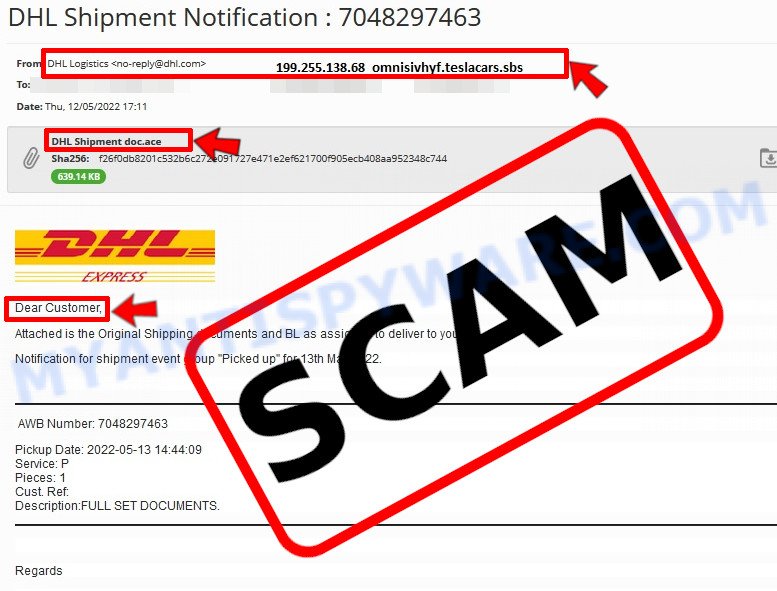Have you come across an email claiming to be from DHL EXPRESS with a subject like “DHL Shipping Delivery Notification”, asking you to click a link to check your Shipping Document?

Question: Is it normal for DHL to ask you to click a link to confirm your Billing Address like this?
Investigation Findings: The link labeled “CLICK HERE” leads to a phishing site at ipfs.flk-ipfs.xyz that mimics DHL’s website to trick you into providing your personal information.
Answer: This is a fraudulent email attempt. 💡 To protect yourself from scams like this, avoid clicking on links in unsolicited emails. Always verify by checking directly with the company through their official website or customer service. Additionally, look out for suspicious URLs that don’t match the official company domain.
A typical “DHL Shipping Delivery Notification” scam email reads as follows:
Subject: DHL Shipping Delivery Notification
From: DHL EXPRESS
Incoming Shipment NotificationReceiver’s ID: xxxxxxx
Delivery: 3/3/2025 .
Shipping Doc: click below to reviewTo fast-track your delivery, kindly CLICK HERE. to check your Shipping Document and confirm your Billing Address.
The “DHL Shipping Delivery Notification” email is a phishing scam that targets your personal and financial information. This fake email claims to be from DHL EXPRESS and tricks you into thinking there’s a shipment coming your way. It includes links that supposedly let you check your shipping document and confirm your billing address.
This email might look real, but it’s just a trap to get you to click on links that lead to a phishing site, ipfs.flk-ipfs.xyz, which pretends to be a DHL EXPRESS site. Clicking on the link can put your sensitive information at risk. Cybercriminals use these tactics to steal your data and maybe even your money.

These phishing scams usually appear out of the blue and often use fake email addresses that look similar to the real ones. It’s important to be on high alert and not click on any links or provide any information.
💡 If you receive a suspicious DHL email, delete it right away and do not click on any links. To protect yourself, make sure your software is up-to-date and consider using reliable security software. Always verify emails by contacting the official company through their legitimate website or customer service.
Summary Table
| Name | DHL Shipping Delivery Notification Scam |
| Type | Phishing Email |
| Source | DHL EXPRESS (impersonated) |
| Target | Email recipients |
| Objective | Steal personal information |
| Phishing Site | ipfs.flk-ipfs.xyz |
📧 What to Do When You Receive the “DHL Shipping Delivery Notification” Scam Email
We advise everyone who receives this email to follow the simple steps below to protect yourself from potential scams:
- ❌ Do not believe this email.
- 🔒 NEVER share your personal information and login credentials.
- 📎 Do not open unverified email attachments.
- 🚫 If there’s a link in the scam email, do not click it.
- 🔍 Do not enter your login credentials before examining the URL.
- 📣 Report the scam email to the FTC at www.ftc.gov.
If you accidentally click a phishing link or button in the “DHL Shipping Delivery Notification” Email, suspect that your computer is infected with malware, or simply want to scan your computer for threats, use one of the free malware removal tools. Additionally, consider taking the following steps:
- 🔑 Change your passwords: Update passwords for your email, banking, and other important accounts.
- 🛡️ Enable two-factor authentication (2FA): Add an extra layer of security to your accounts.
- 📞 Contact your financial institutions: Inform them of any suspicious activity.
- 🔄 Monitor your accounts: Keep an eye on your bank statements and credit reports for any unusual activity.
🔍 How to Spot a Phishing Email
Phishing emails often share common characteristics; they are designed to trick victims into clicking on a phishing link or opening a malicious attachment. By recognizing these signs, you can detect phishing emails and prevent identity theft:

💡 Here Are Some Ways to Recognize a Phishing Email
- ✉️ Inconsistencies in Email Addresses: The most obvious way to spot a scam email is by finding inconsistencies in email addresses and domain names. If the email claims to be from a reputable company, like Amazon or PayPal, but is sent from a public email domain such as “gmail.com”, it’s probably a scam.
- 🔠 Misspelled Domain Names: Look carefully for any subtle misspellings in the domain name, such as “arnazon.com” where the “m” is replaced by “rn,” or “paypa1.com,” where the “l” is replaced by “1.” These are common tricks used by scammers.
- 👋 Generic Greetings: If the email starts with a generic “Dear Customer”, “Dear Sir”, or “Dear Madam”, it may not be from your actual shopping site or bank.
- 🔗 Suspicious Links: If you suspect an email may be a scam, do not click on any links. Instead, hover over the link without clicking to see the actual URL in a small popup. This works for both image links and text links.
- 📎 Unexpected Attachments: Email attachments should always be verified before opening. Scan any attachments for viruses, especially if they have unfamiliar extensions or are commonly associated with malware (e.g., .zip, .exe, .scr).
- ⏰ Sense of Urgency: Creating a false sense of urgency is a common tactic in phishing emails. Be wary of emails that claim you must act immediately by calling, opening an attachment, or clicking a link.
- 📝 Spelling and Grammar Errors: Many phishing emails contain spelling mistakes or grammatical errors. Professional companies usually proofread their communications carefully.
- 🔒 Requests for Sensitive Information: Legitimate organizations typically do not ask for sensitive information (like passwords or Social Security numbers) via email.
✅ Conclusion
We hope this article has helped you understand more about the “DHL Shipping Delivery Notification” Scam Email and how to avoid falling victim to scammers. If you have received a phishing email that is similar but not identical to the example above, please post it in the comments section of this article. This helps us warn other users about potential scams and improve our resources to protect you better. Stay safe and vigilant! 🛡️















